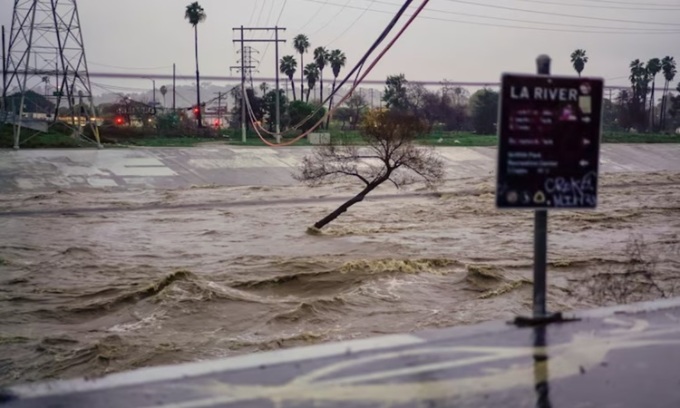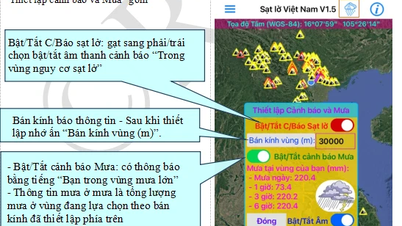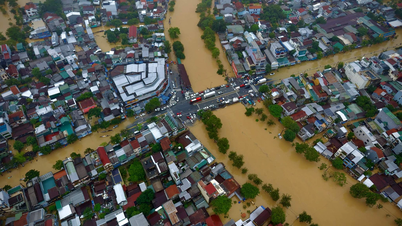The US National Weather Service predicts El Nino will weaken in the coming months, giving way to La Nina, which could cool global temperatures.

Flooding in Los Angeles on February 5. Photo: Washington Post
Signs of a record-breaking El Niño global climate pattern have become apparent in recent weeks, including devastating wildfires in South America and flooding in California. However, scientists predict the pattern could disappear within months, according to the Washington Post . Forecasters at the US National Weather Service warned of El Niño on February 8, predicting a 55% chance of the opposite pattern developing by August 2024.
The development of La Nina has major impacts on weather in the United States and around the world . It can temporarily slow the global warming that began about nine months ago when El Nino took hold. La Nina is also known for fueling a strong and destructive Atlantic hurricane season, while also increasing drought conditions in Southern California and the U.S. Midwest. It tends to moderate global temperatures. While it won’t stop the planet’s warming over the past decade, La Nina can reduce the extreme levels of warming that scientists have recently observed.
January 2024 was the warmest month on record for Earth, marking the eighth consecutive month of record temperatures. It also marked the end of a 12-month period in which the planet reached the worrying milestone of 1.5 degrees Celsius above the 19th-century average, before fossil fuel consumption became widespread, according to the European Union's climate change agency, Copernicus Climate Change Service.
What are El Nino and La Nina?
Whether the Earth's weather is influenced by El Niño or La Niña depends on conditions along the equatorial Pacific Ocean. When the east-west trade winds weaken or even reverse, warm ocean water collects along the surface of the central and eastern Pacific, leading to El Niño and its knock-on effects on weather around the world, including warmer-than-normal conditions in the southern United States, including Southern California, a weakened Atlantic hurricane season, and drought and wildfires in Indonesia and southern Africa.
Climate scientists' predictions for the coming months
Forecasters at the National Weather Service said on February 8 that the warmth in the eastern and central eastern Pacific Ocean decreased in January, as did the wind patterns associated with El Nino. Meanwhile, climate forecasting models indicate that El Nino will remain weak through the spring months. The forecast predicts a 79% chance of “neutral” conditions, absent of both El Nino and La Nina, occurring between April and June 2024.
The researchers note that it can be difficult to predict how El Niño or La Niña will develop in the spring months, as the model often switches around that time, making it more challenging to predict trends. But rapid shifts to La Niña are common after record-breaking El Niños, like the current one. Similar examples occurred during the strong El Niños of 1982-1983 and 1997-1998, according to Tom Di Liberto, a climate scientist at the US National Oceanic and Atmospheric Administration.
Regardless of how quickly it weakens, El Niño is likely to continue influencing global climate patterns for months to come. “Even though it has passed its peak, it still has some impact,” Di Liberto said.
Impact of transition to La Nina phenomenon
Scientists will be closely watching how the shift from the warming pattern of El Niño to the cooling influence of La Niña could impact average temperatures around the world. That could help answer the crucial question of whether the pace of global warming and climate change is accelerating.
It's possible that a shift to La Nina could moderate global temperatures in 2024 and prevent them from exceeding 2023, supporting the hypothesis that 2023 marks a stable path for global temperatures, according to Gavin Schmidt, director of NASA's Goddard Institute for Space Studies.
But if 2024 ends up warmer than scientists predict, despite the existence of the La Niña pattern, it could add to evidence that the system has changed. Climate change also provides more data and opportunities to learn how global warming might affect El Niño and La Niña. Climate scientists don’t have a clear answer yet, but they suspect the frequency of strong El Niño and La Niña events will likely increase over the next century.
An Khang (According to Washington Post )
Source link



![[Photo] Draft documents of the 14th Party Congress reach people at the Commune Cultural Post Offices](https://vphoto.vietnam.vn/thumb/1200x675/vietnam/resource/IMAGE/2025/10/28/1761642182616_du-thao-tai-tinh-hung-yen-4070-5235-jpg.webp)
![[Photo] National Assembly Chairman Tran Thanh Man received a delegation of the Social Democratic Party of Germany](https://vphoto.vietnam.vn/thumb/1200x675/vietnam/resource/IMAGE/2025/10/28/1761652150406_ndo_br_cover-3345-jpg.webp)
![[Photo] Flooding on the right side of the gate, entrance to Hue Citadel](https://vphoto.vietnam.vn/thumb/1200x675/vietnam/resource/IMAGE/2025/10/28/1761660788143_ndo_br_gen-h-z7165069467254-74c71c36d0cb396744b678cec80552f0-2-jpg.webp)































![[Photo] President Luong Cuong attends the 80th Anniversary of the Traditional Day of the Armed Forces of Military Region 3](https://vphoto.vietnam.vn/thumb/1200x675/vietnam/resource/IMAGE/2025/10/28/1761635584312_ndo_br_1-jpg.webp)














































































Comment (0)